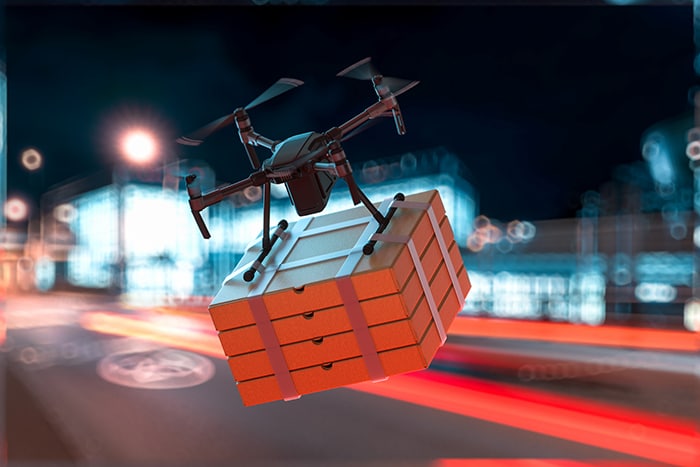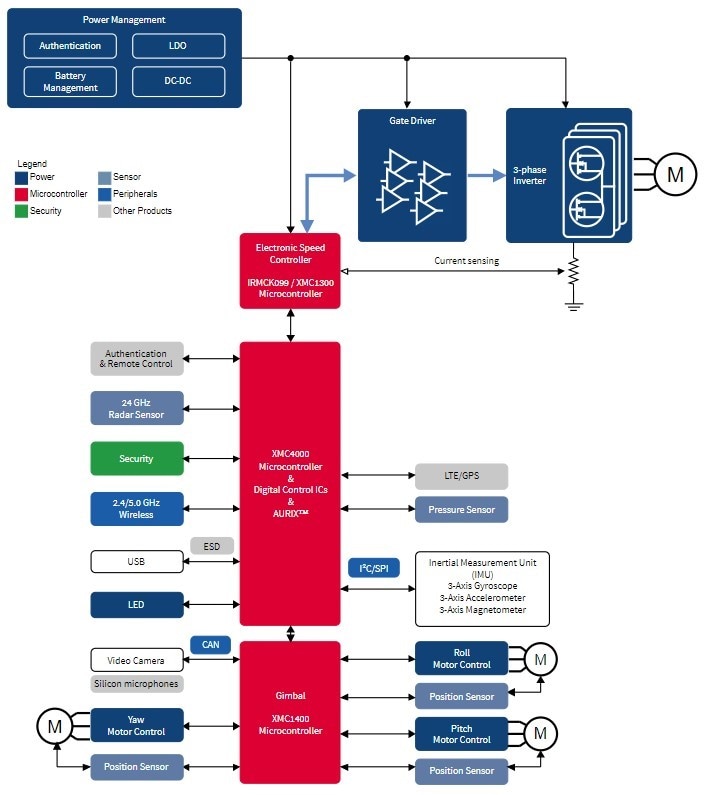When Quadcopter Drones Take Flight

Image Source: Kostsov/shutterstock.com
By Mouser Electronics
Edited May 28, 2020 (Originally Published September 14, 2016)
To anyone who has ever flown a quadcopter,
dictionary definitions of a “drone” don’t do it justice, especially when the standard
definition of drone is “a male bee … which does no work but can fertilize a queen.” The
recent addition of “unmanned aircraft or ship guided by remote control or onboard computers” is too
sparse, so below we offer some positive linguistic ballast to the current dreary characterizations.
Quadcopter by Definition
A drone is an unmanned vehicle that performs tasks while either traveling from its launch point to a specified
destination and back or loitering in a designated area, with or without human intervention while avoiding
collisions with other objects. When operating autonomously, such a vehicle is called an Unmanned Autonomous
Vehicle (UAV) or Unmanned Autonomous System (UAS). These unusual combinations of aeronautic and electronic
technology are made possible by advances and cost reductions in sensors, processors, communications, and
other
technologies. Together, all this low-cost technical wizardry makes it possible for virtually anyone to own one,
even if it is just a toy.
Mouser Electronics carries a full line of quadcopter solutions on its website, including flight control, charger,
battery management, and gimbal control products. Infineon portfolio of products (Figure 1)
meant for multicopters can be found on the Infineon
multicopter solutions page. Cypress, now part of
Infineon, also offers a complete
quadcopter
solution that includes all of the parts needed to design and test fly quadcopters in no time. A special
drone project was created using the Cypress Semiconductor parts at Maker Faire Seattle and Rome to demonstrate
Cypress' Serial
F-RAM and PSoC® 5
programmable system-on-chip (SoC). which offers high-precision analog, unmatched integration, and low power that
help to simplify the drone’s system design. Quadcopter kits such as the one offered by Cypress can help
students better understand physics, control systems, programming, mathematics, and engineering. Quadcopters, or
drones, are not your father’s radio-controlled (RC) Cessna.

Figure 1: Multicopter system block diagram by Infineon. (Source:
Infineon)
A December 2019 MarketLine Industry Profile stated that the global drones market had total revenues of
$9.8 billion (USD) in 2018, representing a compound annual growth rate (CAGR) of 46.9 percent between 2014 and
2018. The MarketLine report also states that the market production volume is expected to rise to 11.7 million
units by the end of 2023.
Consumer drone sales, primarily in North America and China, have been the main driver and represent the vast bulk
of the industry sales. But commercial drone sales were the most lucrative in 2018 (Figure 2),
with total revenues of $5.8 billion, equivalent to 59.1 percent of the market's overall value while consumer
drones contributed revenues of $4.0 billion in 2018, equating to 40.9 percent of the market's aggregate value.
Figure 2: Global
drones market category segmentation: $ million (USD), 2018. (Source: MARKETLINE)
Some might consider quadcopters to be a mere addendum to the RC market that today includes replicas of the
Hindenburg airship. In fact, radio-control was first demonstrated in the late 1800s by Nicola Tesla,
who demonstrated
an RC boat in 1898. Tesla was followed by his associate and 1963 IEEE Medal of Honor winner John Hays Hammond
Jr., the “father of remote-control,” who among more than 400 other things, invented pitch propellers
and single-dial radio tuning.
Figure 3: Tesla demonstrated this radio-controlled boat in 1898 for
which he was awarded a patent. (Source: Nikola Tesla Museum)
RC vehicles have over the years been powered by rubber bands, gasoline, electric motors, “nitro” glow
fuel consisting of methanol, castor oil, and nitromethane (the latter also powers dragsters), and rocket
engines. They range in price from a few hundred dollars to tens of thousands of dollars for huge homebrew RC
aircraft.
Applications Unlimited
The supremely nimble capabilities of quadcopters, along with their relative low cost, are making quadcopters the
go-to aircraft for dozens of applications ranging from simply taking high-resolution photos and video from above
for personal use, to photojournalism, and filmmaking. Other applications include search and rescue, monitoring
utilities, border patrol, surveying, law enforcement and crowd monitoring, and wildlife and land management
(including counting wildlife and detecting forest fires, illegal hunting, and many more applications).
More noteworthy drone applications include Amazon’s Prime
Air, which is currently in development, and Zipline.
Amazon’s proposed package delivery system would deliver small packages up to
2kg within 30 minutes from a 24km delivery location of a participating Amazon order fulfillment center.
Amazon’s Prime Air UAV is based on a fully shrouded hybrid design which can take-off and land vertically
like a helicopter and transition easily to a more efficient and aerodynamic drone resembling more of an airplane
with the shroud acting as wings allowing it to operate safely in gusty wind conditions. Besides advances in
efficiency, Amazon’s newest drone will be able to identify static and moving objects from any direction
while in flight. The drone will employ myriad of sensors and advanced algorithms, such as multi-view stereo
vision, to detect static objects such as a chimney and proprietary computer-vision and machine-learning
algorithms to detect moving objects, like a paraglider or helicopter. Amazon is awaiting U.S. Federal Aviation
Administration approval and expects Prime Air will be delivering packages via drone to customers soon.
Furthermore, Prime Air is one of Amazon’s sustainability initiatives to help achieve Shipment Zero, and
make all Amazon shipments net zero carbon, with 50 percent of all shipments net zero by 2030.
Zipline is already fulfilling its business model by making thousands of daily deliveries of lifesaving products
globally, according to its website. Zipline’s UAV resembles more of an
airplane, but it incorporates many of the same components found in Infineon’s multicopter system block
diagram.
A secondary consequence of Zipline’s venture, and others like it, including Amazon’s Prime Air, is
that these companies’ efforts to help drive and sustain the continual evolution of drone technology. In
turn, that helps drive newer and innovative drone hardware and software sales.
How Do Quadcopters Work?
A quadcopter is considerably more complex than four sets of electric-motor-powered rotors operated by remote
control. A typical First-Person View (FPV)-type quadcopter allows the “pilot” to view real-time
images from the drone’s camera on a video display, smartphone, or with goggles. A hand-held remote unit
controls all flight functions as well as others, depending on what sensors it carries. The control unit contains
a transceiver operating on up to nine channels within the unlicensed Industrial Scientific and Medical (ISM)
bands at 2450MHz and 5.8GHz, and in some cases, Wi-Fi. One frequency, usually 2450MHz, is used for control and
the higher frequency for video transmission. Operating the controls sends a signal to drone’s receiver and
then to the drone’s control board, which commands the motors to spin either clockwise or counterclockwise
and at speeds that alter the flight direction of the drone.
Flying any aircraft requires the ability to balance its weight by generating lift and balance moments around its
center of gravity, which is accomplished by creating opposite moments. To understand how quadcopters work, see
Figure 4. In a quadcopter, both lift and balance are accomplished by the four rotors, the most
difficult challenge being generating the moments required to stabilize it while simultaneously producing
control
forces that allow it to move.
Figure 4: How rotors
allow drones to fly. Source: Barry Manz
Each quadcopter rotor produces both thrust and torque as well as a drag force opposite to the vehicle's direction
of flight. When all rotors spin at the same velocity with two rotors spinning clockwise and two rotors spinning
counterclockwise (left in Figure 4), the aircraft remains in place while providing lift for
maintaining altitude. When two rotors deliver more thrust and two less, the aircraft turns (center in
Figure 4.) Finally, to induce pitch and roll, one rotor gets more thrust, two get much less,
and the remaining rotor gets the least (far right, Figure 4.) In this way, quadcopters, unlike
helicopters, require no tail rotor, a significant benefit.
Quadcopters can achieve greater stability by using two sets of rotors in what is called a coaxial configuration,
with one set of rotors mounted above the other on a concentric shaft with the same axis of rotation but spinning
in the opposite direction. This approach, which is used on some commercial and military helicopters, is also
available on some of the most expensive commercial and consumer quadcopters. However, like helicopters (but not
fixed-wing aircraft), quadcopters have no inherent aerodynamic stability, so they need an onboard computer to
fly, without which they fall like a rock. They also need a battery-operated power supply, rotor
speed
controllers, and software, and to be fully autonomous they have to combine information from their onboard
three-axis gyroscope, magnetometer, and accelerometer with data from GPS and a barometer; all to determine
orientation and location.
All of the resulting data, as well as inputs from sensors (including
cameras) must also be
processed, transmitted, and received using an onboard radio transceiver and antennas. This requires prodigious
amounts of processing power, high-speed memory, and multiple forms of connectivity in a small package.
Fortunately, all this is currently achievable.
DIY Redefined
Not surprisingly, the quadcopter—drone—DIY community is growing rapidly, and numerous websites can
help in building a quadcopter from scratch.
A lot of these open-source hardware community-built sites provide users with the mechanical and electrical
specifications needed for their drone builds, including the flight management such as Autopilot, cameras,
gimbals, actuators, and smart battery management standards, and all are made available from Github repositories.
Like all hobbyist communities, drones have many suppliers that give drone builders the ability to highly
customize their aircraft, and hundreds of rotors, modules, controllers, and other components are available. For
the most technically astute and handy, it is possible to create a drone that can fly beyond the line of sight,
miles from the pilot, using lower-frequency transceivers that have greater range. If the drone has the payload
capacity and the developer is well-versed in electronics, applications are limited only by the imagination and
local and federal regulations.
What is to Come
Even though quadcopters can already achieve astonishing feats, it is likely they will achieve much more in the
years ahead. For example, artificial intelligence and machine learning could allow a quadcopter to make
intelligent decisions based on various types of sensor input. Although both AI and machine learning require
formidable processing power, this could be provided by data centers (that is, the cloud), eliminating the need
for extensive processing to be performed in the drone itself. Package delivery services are immensely attractive
to Amazon, UPS, FedEx, and international delivery companies, and the day when drones are buzzing around
neighborhoods is probably in the not-too-distant future. One thing is sure: Drones, UAVs and Quadcopters have
the potential for novel and useful applications that are yet to be seen.
Article Info
This article is comprised of material from Mouser
Electronics technical content staff and Barry Manz. Barry is president of Manz Communications, Inc. and a
regular contributor to Mouser’s technical content in all things RF, IoT, and wireless technologies.
 Singapore
Singapore